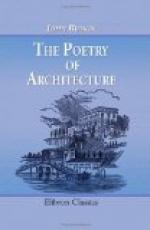A little grotesqueness in form is the more allowable, because the imagination is naturally active in the obscure and indefinite daylight of wood scenery; conjures up innumerable beings, of every size and shape, to people its alleys and smile through its thickets; and is by no means displeased to find some of its inventions half-realized in a decorated panel or grinning extremity of a rafter.
89. These characters being kept in view, as objects to be attained, the remaining considerations are technical.
For the form. Select any well-grown group of the tree which prevails most near the proposed site of the cottage. Its summit will be a rounded mass. Take the three principal points of its curve: namely, its apex and the two points where it unites itself with neighboring masses. Strike a circle through these three points; and the angle contained in the segment cut off by a line joining the two lower points is to be the angle of the cottage roof. (Of course we are not thinking of interior convenience: the architect must establish his mode of beauty first, and then approach it as nearly as he can.) This angle will generally be very obtuse; and this is one reason why the Swiss cottage is always beautiful when it is set among walnut or chestnut trees. Its obtuse roof is just about the true angle. With pines or larches, the angle should not be regulated by the form of the tree, but by the slope of the branches. The building itself should be low and long, so that, if possible, it may not be seen all at once, but may be partially concealed by trunks or leafage at various distances.
90. For the color, that of wood is always beautiful. If the wood of the near trees be used, so much the better; but the timbers should be rough-hewn, and allowed to get weather-stained. Cold colors will not suit with green; and, therefore, slated roofs are disagreeable, unless, as in the Westmoreland cottage, the gray roof is warmed with lichenous vegetation, when it will do well with anything; but thatch is better. If the building be not of wood, the walls may be built of anything which will give them a quiet and unobtruding warmth of tone. White, if in shade, is sometimes allowable; but, if visible at any point more than 200 yards off, it will spoil the whole landscape. In general, as we saw before, the building will bear some fantastic finishing, that is, if it be entangled in forest; but, if among massive groups of trees, separated by smooth sward, it must be kept simple.
91. II. The Cultivated, or blue, Country. This is the rich champaign land, in which large trees are more sparingly scattered, and which is chiefly devoted to the purposes of agriculture. In this we are perpetually getting blue distances from the slightest elevation, which are rendered more decidedly so by their contrast with warm corn or plowed fields in the foreground. Such is the greater part of England. The view from the hills of Malvern is




